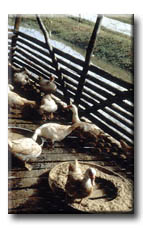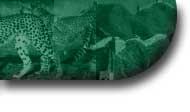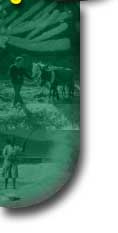Fish-Farming to
Protect the Rain Forest
(Any time you see a link, you can click it for more information
on that word or topic)
What's it all about?
In response to destructive slash-and-burn agricultural techniques, farmers
in Peru are moving to something called "integrated
aquaculture". Fish-farming, using non-destructive organic methods,
is providing a source of food and income for Peruvian farmers, without
endangering the fragile ecosystem of the Amazon rain
forest.
What's So Special About the Rain Forest??
The earth's climate and atmospheric conditions, its variety of soil
and water conditions each supporting unique kinds of life and offering
different opportunities for human habitation, all depend on a complex
interaction among its different environments - deserts, forests, oceans,
ice caps, grasslands, wetlands, and so on. The characteristics of any
one kind of environment depend on the other environments that surround
it, and even on environments hundreds and thousands of miles away.
As much as every single environment contributes in an important way
to maintaining life on earth, a good case can be made for the special
importance of the tropical rain forest.
In a tropical forest, nature assumes some of its most extraordinary
and beautiful forms. But as striking as forest life is to the human eye,
its greatest benefits are harder to see. They have to do with the most
basic elements of life -- soil, atmosphere, and climate; food, water,
fuel and shelter. It's not only the teeming life of the forest that is
threatened when the forest is cut down, but life -- including human life
-- everywhere on the globe.
Forests once covered six million square miles of the earth's surface.
We've lost more than a third of that already, and the rate of destruction
is going up. Today, nearly fifty acres a minute are cut down -- an area
the size of Great Britain each year.
In the history of the earth, plants were the first organisms on dry
land. In order for other life forms to evolve, energy had to be captured
from the nonliving environment.
This task fell to the plants, which accomplished it by photosynthesis.
Plants capture the sun's energy and use it to produce foods which other
organisms consume.
Peru is a land of dramatic contrasts -- from the broad deserts that
line the Pacific coast to the fertile valleys along the western slope
of the Andes -- to the towering mountains themselves -- to the Amazon
basin, which begins in the streams that descend the mountains' eastern
slope.
Here, in the Amazon basin, the tropical forest begins. Like others of
its kind around the world, the Amazon forest is a fragile and endangered
ecosystem.
Genetic Diversity
On average, an acre in a tropical rain forest is home to ten times as
many living species as another environment. This means that the genetic
material of the tropical rain forest is richer and more diverse than that
of any other environment, both within a given species and across the variety
of species.
A tropical rain forest is a reservoir of genetic
diversity, and as such it is very important for humans. We are more
likely to find a valuable new medicine, a new kind of food, or a new pest-resistant
or disease-resistant strain of an already familiar food in a tropical
rain forest than anywhere else on earth.
Climate Regulation
Tropical rain forests also play a central role in the regulation of
the earth's climate, both regionally and globally. They recycle vast amounts
of carbon dioxide into oxygen, a process critical to all kinds of life
and which, by removing carbon dioxide from the air, tends to cool the
earth's average temperature. They recycle rainfall into new clouds, which
provide further needed rainfall not only for the rain forest itself but
for agricultural regions far outside the forest's borders. Both the cloud
cover and the rain also keep temperatures cooler.
Water
Tropical rain forests are the source of many of the world's most important
watersheds
as well. The water that is not used by the plants and animals of the tropical
rain forest or recycled into clouds finds its way into river systems that
sustain, by providing water for irrigation, navigation, and drinking,
some of the largest concentrations of people on the planet - in South
and Southeast Asia, in Africa, and in South America.
The levels at which the tropical rain forest releases water into its
rivers, the seasonal rates at which it does so, and the nutrients with
which the forest's abundant life fills the rivers are all features of
the rain forest that people who live far from the forest itself depend
on for their daily survival.
What Are the Dangers to the Rain Forest?
For all its value, the tropical rain forest is one of the most endangered
environments on earth. People seek many things in a tropical rain forest,
and two of the most widely sought pose deep risks to the forest's survival.
The first of these is wood, which is harvested and sold, usually for
export. In part to save money and realize higher profits, and in part
because of the very density of a tropical rain forest, such harvesting
is typically carried out by bulldozers. In contrast to the selective cutting
done in temperate forests, timber harvesting in tropical rain forests
usually leaves a barren landscape that has no chance to regenerate itself.
The second threat to the rain forest comes from attempts to convert
it to agricultural uses, ranging from small single-family farms to vast
cattle ranches run by multinational corporations. Because the nutrients
in a tropical rain forest are held mostly in the foliage, these efforts,
too, soon leave behind an empty and lifeless terrain. Topsoil in the rain
forest is very thin and must be held in place by trees and other forest
plants; when those are cleared away the land rapidly becomes eroded, hard
and rocky, unsuitable for continued ranching or farming.
Tropical rain forests tend to be located in countries where sources
of immediate income are needed, from the individual to the national levels.
They are often countries with large populations, whose governments seek
to open up new territories where people can get food and livelihood from
farming. That desire, and the desire on the part both of private companies
and of governments to realize a profit from the forest and its land -
either from lumbering or from other activities, such as mining - put the
rain forest at risk.
Getting a short-term livelihood or profit from the rain forest can bring
troubling long-term consequences. Most rain forest species can live only
in the rain forest environment, so the loss of that environment means
the loss of the species. Since there are more species in the rain forest
than anywhere else, rain forest destruction presents the greatest single
danger to genetic diversity in the world today.
Because tropical forests are so dense with plant life, they are often
shrouded by clouds. When a stretch of forest is destroyed, the loss of
these clouds beings a dramatic increase in rainfall over a wide territory.
When trees are cleared and crops planted, only a season or two of farming
is possible. Then the plot is abandoned. All around the world, land cleared
in rain forests will never be fertile again: the heavy rains have washed
away the topsoil, and the layer below, now exposed to the sun, takes on
a brick-like character. Less than one percent of the Amazon basin can
support sustained cultivation.
The loss of large amounts of plant material when the rain forest is
cut down means less carbon dioxide is taken from the air; in addition,
the air gains carbon dioxide when the cleared plant material is burned,
which it usually is once the tree trunks have been removed. Both of the
processes contribute to the greenhouse
effect and add to the possibility that the earth's climate will be
disturbed by excessive warming.
The disappearance of root systems means that the abundant rain water
cannot be held; this water washes away and adds to the risk of floods.
Clearing the forest brings erosion. Erosion is more than a scar on the
landscape. It creates silt, which clogs rivers, damages irrigation, and
leads to flooding.
The rocky earth that is left behind reflects more light and heat into
the atmosphere, adding to the likelihood that the climate will get warmer.
The likelihood goes up further when the loss of plant material brings
diminished cloud cover. This means not only less cooling but also less
rainfall.
Within the rain forest's original boundaries, the process known as desertification
results from the loss of clouds, rain, and topsoil; outside the forest's
edges, deserts form because clouds and rain that once blew in from within
the forest no longer do so.
While there is still some debate over the extent of global warming -
it is known that carbon dioxide concentrations in the atmosphere have
gone up by one fifth in this century, but the evidence for actual changes
in temperature are suggestive but not conclusive - there are well-documented
cases of desertification and of flooding due to siltation
from a number of rain forest regions that have undergone extensive cutting.
What's it All About?
Many nations are taking steps to protect the tropical rain forests within
their borders by creating parks and nature reserves. But it is clear that
this kind of action can protect only a fraction of the world's rain forest
lands. Maintaining parks and reserves is expensive, especially for governments
who are trying to meet the competing needs of other people for income
and for land on which to live.
Juan Guevera's job is to help the farmers who live in the area around
the city of Pucallpa, in the part of the Amazon Basin that lies in Peru,
meet their needs for food and income. For many years, these farmers have
relied on a kind of agriculture known as slash-and-burn, which involves
burning the rain forest plant cover to create plots for cultivation. Because
land cleared in this way is only good for a couple of growing seasons,
and because the population in the area is rising rapidly, the net effect
of this kind of agriculture is a significant loss of rain forest, and
no significant improvement in income or nutrition.
Among the effects of damage to the rain forest in the Peruvian Amazon
has been a change in the annual patterns of river flooding, and this change
in turn has put the survival of a number of native species of Amazonian
fish at risk. They face a further challenge from species introduced for
commercial purposes from outside of the Amazon Basin, some of whom are
better adapted to the new river patterns. Fish catches from area rivers
have declined in recent years.
What is Aquaculture?
Fish-farming, or "aquaculture",
is an ancient practice, a means by which many peoples around the world
provide for their food and livelihood.
In Pucallpa, Peru, Juan Guevera is engaged in a project that holds the
promise of aquaculture playing another role. There, it may contribute
to the protection of the fragile ecosystems of the Amazon rain forest.
Like many river basins in the area, the Pucallpa region has attracted
tens of thousands of agricultural migrants from the mountains and cities.
Mining, timbering, and agricultural projects resulting from the rapid
growth of the region are taking a toll on the landscape.
Guevera came to Pucallpa as an agricultural researcher. His job was
to advise people on how best to gain a living from the land. But he was
uneasy about many of the ways this was being done.
"In this Amazon region, extractive
activities have been steadily increasing the scope of their operations.
This has caused very serious deforestation. Fish farming, unlike these
extractive activities, is different. It can be undertaken in the tropics
without any drastic effects on the environment."
So What's the Solution?
In Peru, Juan Guevera has seen deforestation
bring many of these problems. The annual floods now come faster and deeper.
Nutrients washed away are not replaced, and the river waters themselves
grow poorer. The supply of fish during the rainy season drops considerably.
In turning to aquaculture, Guevera and his colleagues were turning to
a practice that could feed and employ many of these immigrants -- without
damaging the tropical forest.
What is unique about integrated aquaculture is how self-supporting it
is. In other parts of the world, fish farming requires expensive grain
food. As Guevera explains, that is not the case here:
"The people who are immigrating into this area have not traditionally
been fish farmers. So, the scheme we are putting into effect here is integrated
with the kind of agriculture they do practice. But, since their traditional
farming methods produce few byproducts, and since protein is very expensive,
we've integrated animals into the process."
 Guevera
sought a method that was simple and small-scale, and that used available
livestock. Most people in the area already had the few pigs, ducks or
chicken that are needed. The animals drop their wastes into the pond from
raised platforms. The wastes support a population of plankton, which the
fish eat along with insects and leaves. Guevera
sought a method that was simple and small-scale, and that used available
livestock. Most people in the area already had the few pigs, ducks or
chicken that are needed. The animals drop their wastes into the pond from
raised platforms. The wastes support a population of plankton, which the
fish eat along with insects and leaves.
Such integrated aquaculture keeps farmers' costs low, which is particularly
important for farmers living at the rain forest's edge, as the cost of
transporting their products to market is likely to be relatively high,
due to their distance from urban centers, and therefore they must, in
order to be competitive, keep all other costs low.
"These fish are herbivorous
species with a short food chain. They grow very quickly on a food base
of mainly vegetable products."
The results are indeed dramatic. Annual yield of fish for a two and
a half acre pond is 11,500 pounds -- an average of more than thirty pounds
per day. This brings nutritional benefits to the family and community,
in the form of much-needed protein, and provides a considerable surplus
that can be taken to market.
Guevera and the other members of his research team -- called "IVITA"
-- work hard to make the fish ponds productive. They determine the ideal
balance of animal wastes that go into the pond. They've studied more than
three hundred varieties of Amazonian fish in order to find the ones best-suited
to this kind of pond. So far, the choices are: the gamitana, the
boquichico, and the sabolo.
"The gamitana and sabolo are native species that bring
a high price commercially. But since they're migratory species that don't
reproduce well in ponds, we're experimenting with artificial reproduction.
For Guevera, it was important to work with species native to this part
of the Amazon basin. Imported species might find their way into the Ucayali
and other nearby rivers, where they would compete with the native stock.
During the long rainy season, when the swift rivers overflow their banks,
the catch from local streams is meager. The cost of fish doubles or triples,
and malnutrition is a severe problem. The aquaculture project allows for
a steady supply during the entire year.
Guevera, his assistant Guadalupe Contreres, and other members of the
IVITA team provide fish fingerlings
and plankton to families who want to begin their own fish culture. They
provide advice on how to build and maintain the pond. Individual families
can manage their own ponds; so far, six families have begun to do so,
and their sense of pride and enthusiasm is clear.
The initial costs for the animals, along with the cost of feeding and
maintaining them, are very low. A tractor has to be hired for the initial
digging. Banks in the area provide loans for this service. Low cost and
high productivity are important for the role the Pucallpa project plays
in the protection of the forest.
Guevera feels that the small-scale, integrated aquaculture methods developed
in Pucallpa can be applied anywhere in the Amazon basin. Deforestation,
population growth, and malnutrition occur in many parts of the region.
Integrated aquaculture in the Peruvian Amazon has many benefits. It
provides a source of nutrition and of income for farmers who might otherwise
engage in a kind of agriculture that would damage the rain forest. A further
benefit is that the ponds are helping to maintain the native Amazonian
fish species. IVITA monitors and studies the local species, and where
appropriate encourages farmers to raise these.
The solution that Juan Guevera and the farmers he works with have developed
is part of a growing international consensus about how to keep rain forests
alive. In the past, the need to protect an endangered environment almost
always led to calls for new parks and reserves – for effectively
removing human populations from everyday contact with that environment.
It has been and remains politically and economically difficult for struggling
countries to do this.
The new consensus is to find a way that people can coexist with the
rain forest. One way is to live at its edges and engage in activities
that sustain rather than harm the forest. If it can be shown that the
long-term benefits of such practices, not just for the rain forest ecology
and the global environment, but for the well-being of the people who live
in and near the rain forests, outweigh the short-term profits from lumbering,
mining and slash-and-burn agriculture, then the rain forests will face
a more secure future.
There's abundant reason, based on what we know about the role of rain forests
in our global economy, to try to save these precious resources.
The forests are so rich with life that the number of species lost when
an area of tropical forest is destroyed is ten times the number lost when
other environments disappear.
Near Pucallpa, deforestation endangers jaguars, and threatens the rare
pink dolphins that swim in the Ucayali River.
There's also reason to try to save tropical forests on grounds of what
we don't know. When we consider all the medical and industrial substances
we depend on that come from the rain forests, the odds favor the likelihood
that we can derive great benefits from the five out of six species we
have not yet even identified.
The Amazon forest needs protection, to be sure, but it cannot simply
be fenced off. Its future can also be made more secure when the expanding
populations at is edges find ways to prosper without harming the forest.
The work of Juan Guevera and the IVITA team allows the people of Pucallpa
to do just that.
Integrated aquaculture is a way that families can produce their own
food with minimal damage to the fragile environment around them.
|













